 W
WAnimoog is a music synth mobile app designed for iPad, iPhone and BlackBerry Z10. Animoog is powered by Moog Music's Anisotropic Synthesis Engine.
 W
WThe Realistic Concertmate MG-1 is an analog synthesizer manufactured by Moog Music in 1981 and sold by Radio Shack from 1982 to 1983 under their "Realistic" brand name. It was produced without some standard Moog features, such as pitch and modulation wheels, as a cost-cutting measure aimed at achieving a lower price for the consumer market. The synthesizer also featured a pair of pass-through RCA jacks, which allowed users to mix radio or records into the final live synthesized sound output.
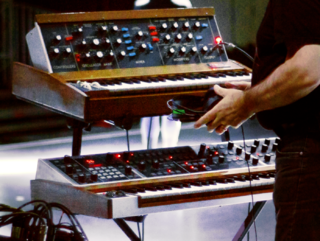 W
WThe Memorymoog is a polyphonic electronic music synthesizer manufactured by Moog Music from 1982–85, the last polyphonic synthesizer to be released by Moog Music before the company declared bankruptcy in 1987. While comparable to other polyphonic synthesizers of the time period, such as the Sequential Circuits Prophet-5 and Oberheim OB-Xa, the Memorymoog distinguished itself with 3 audio oscillators per voice and greater preset storage capacity.
 W
WThe Moog model 2090 Micromoog is a monophonic analog synthesizer produced by Moog Music from 1975–79.
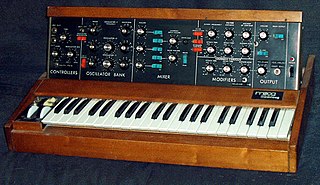 W
WThe Minimoog is an analog synthesizer first manufactured by Moog Music between 1970 and 1981. In the 1960s, synthesizers—in the form of large, expensive, and complex modular synthesizers—were inaccessible to most musicians. The Minimoog was designed as an affordable, portable, simplified instrument which combined the most useful components of the Moog synthesizer in single device. It was the first synthesizer sold in retail stores. It was first popular with progressive rock and jazz musicians and found wide use in disco, pop, rock and electronic music.
 W
WThe Minimoog Voyager or Voyager is a monophonic analog synthesizer, designed by Robert Moog and released in 2002 by Moog Music. The Voyager was modeled after the classic Minimoog synthesizer that was popular in the 1970s, and is meant to be a successor to that instrument.
 W
WThe Grandmother is an analog semi modular, 32 key synthesizer released by Moog Music Inc. incorporating circuits based on the Moog modular synthesizer Model 15, and the Minimoog.
 W
WThe Little Phatty is a monophonic analog synthesizer manufactured by Moog Music from 2006 to 2013, preceded by the Voyager and succeeded by Voyager Old School. Its design was conceived, in part, by Robert Moog himself, and is the last instrument to have that distinction, although the primary engineer was Cyril Lance. It is also the first Moog product to be produced following his death. Jordan Rudess of the band Dream Theater also assisted with the design of the product.
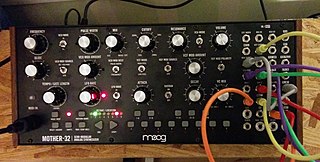 W
WThe Mother-32 is a semi-modular analog synthesizer. Introduced in 2015, it was the first tabletop unit produced by Moog Music. It has a single voltage controlled audio oscillator, a voltage controlled low frequency oscillator, a voltage controlled filter switchable between high and low pass, an AR envelope generator with switchable sustain, a voltage controlled amplifier, and a white noise generator. It also features a 32–step monophonic sequencer, a 13-note keypad, and a 32-point patch bay including assignable outputs. The Mother-32 is manufactured in Asheville, North Carolina.
 W
WThe Moog Sub 37 is a monophonic analog synthesizer manufactured by Moog Music from 2014. The synthesizer has an analog signal path and digital modulators. In May 2017, Moog announced its successor, the Moog Subsequent 37 CV, which featured an additional four assignable CV outputs, and two gate output in a limited edition of 2000 units.
 W
WThe Moog synthesizer is a modular synthesizer developed by the American engineer Robert Moog. Moog debuted it in 1964, and Moog's company R. A. Moog Co. produced numerous models from 1965 to 1980. It was the first commercial synthesizer, and is credited with creating the analog synthesizer as it is known today.
 W
WThe Mother-32 is an analog semi-modular desktop synthesizer released by Moog Music Inc. in 2015.
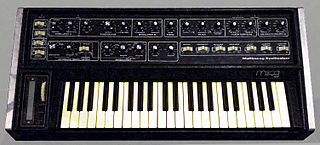 W
WThe Multimoog is a monophonic analog synthesizer manufactured by Moog Music from 1978 to 1981. Derived from the earlier Micromoog, the Multimoog was intended to be a less expensive alternative to the Minimoog. It nevertheless had some advanced features which the Minimoog did not—most notably, it was one of the earliest synthesizers to feature aftertouch capability.
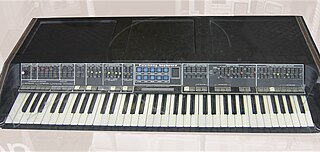 W
WThe Polymoog is a hybrid polyphonic analog synthesizer that was manufactured by Moog Music from 1975 to 1980. The Polymoog was based on divide-down oscillator technology similar to electronic organs and string synthesizers of the time.
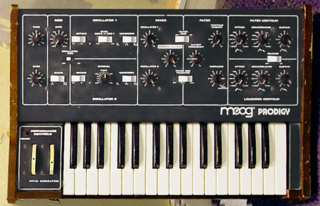 W
WThe Moog Prodigy was a monophonic analogue synthesizer produced by Moog Music from 1979 to 1984. Of the 11,000 produced, versions released after 1981 included a control voltage/gate input on the back that allowed the VCF to be triggered and controlled by an external source. These later versions began at serial number 4610. The official model number of the instrument is 336. 336A would indicate a domestic (US) model, while a 336BX would indicate an export unit.
 W
WThe Moog Rogue is a monophonic analog synthesizer produced by the original Moog Music in the early 1980s, but, was not designed by Bob Moog. Very basic in its design and use, the Rogue featured a 32-note keyboard and two VCOs. VCO number 2 is tunable between a half-step below to an octave above VCO number 1. This allows the Rogue to play atonal sounds like the Moog Prodigy. The Rogue did not have features to allow the user full flexibility to program the patch settings, however the VCF and the VCA were simple in operation. The design of the hard-wired patch system was well thought out and a wide variety of sounds and modulation effects are possible. The Rogue also includes a Sample-and-Hold feature that the Prodigy does not. The synthesizer is most commonly used for its powerful bass. The Rogue is similar in some respects to the famous ARP Odyssey, though smaller and slightly less versatile.
 W
WThe Moog Sonic Six is a duophonic analog synthesizer that was manufactured by Moog Music from 1972 to 1979. Because of its portable design and built-in speaker, the Sonic Six was widely used for lectures and educational purposes, often by Bob Moog himself.
 W
WThe Moog Source is a monophonic Z80 microprocessor-controlled analog synthesizer manufactured by Moog Music from 1981 to 1985. The Source was Moog's first synthesizer to offer patch memory storage. The design was also the first Moog synthesizer to feature a flat-panel membrane keyboard to replace the standard buttons, knobs and sliders, along with multihued panel graphics that were very different from anything Moog offered at the time. Sound wise it is considered to sound more like the original Moog Minimoog than any other synthesizer made by Moog and was introduced as its replacement.
 W
WThe Moog Taurus is a foot-operated analog synthesizer designed and manufactured by Moog Music, originally conceived as a part of the Constellation series of synthesizers. The initial Taurus I was manufactured from 1975 to 1981; a less successful redesign, Taurus II, followed from 1981 to 1983. Instead of a conventional keyboard, the Taurus uses an organ-style pedal board similar to the pedal keyboard of a spinet organ. This control method was chosen because the Taurus was intended to be played by foot while the player's hands played one or more keyboards, although it was often used by guitarists. While the original Taurus featured its own synthesis engine, the Taurus II was essentially the same as the Moog Rogue. In 2010, Moog issued the Moog Taurus III which closely emulates the analog circuitry of the Taurus I, in addition to adding some modern features.